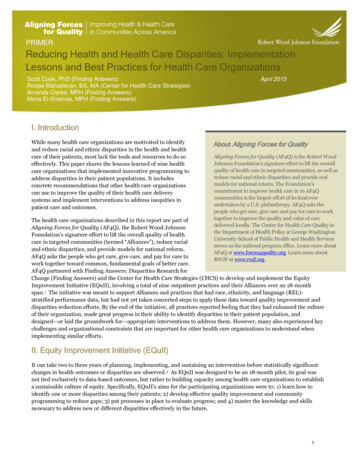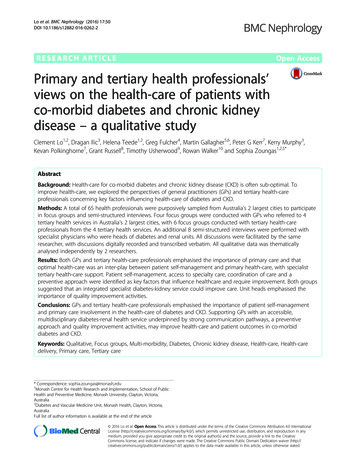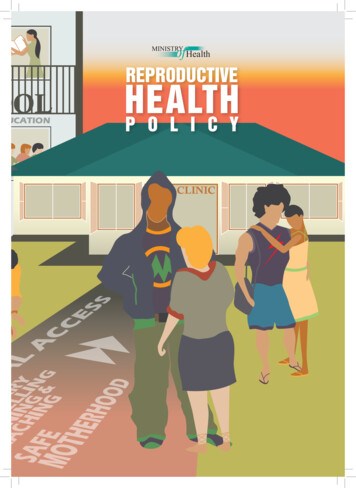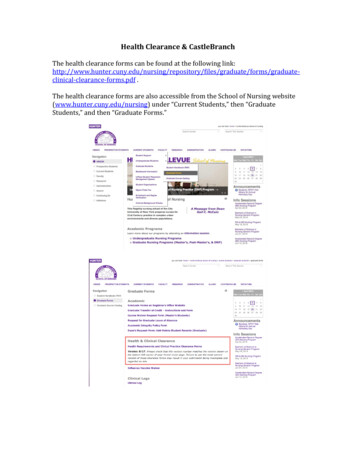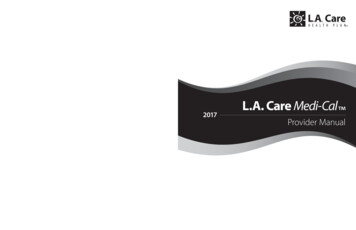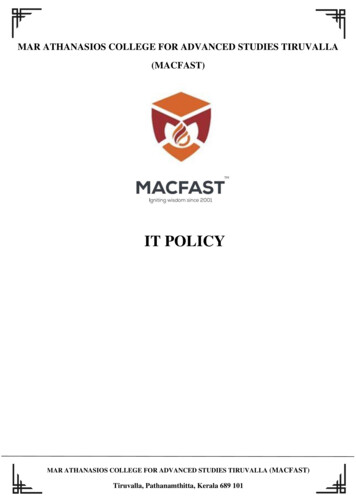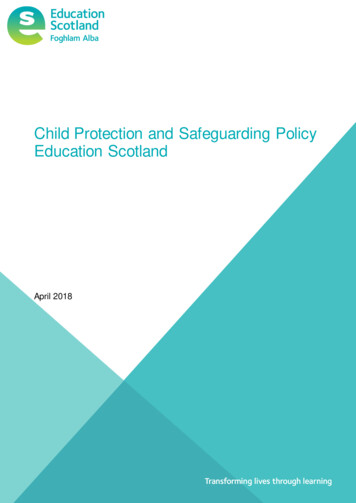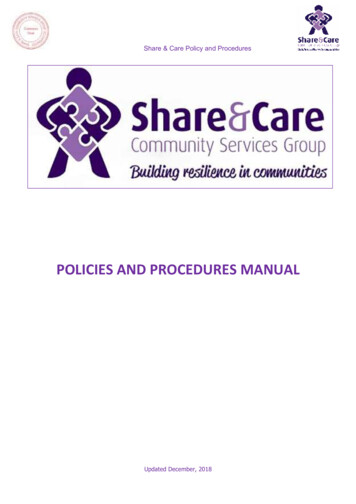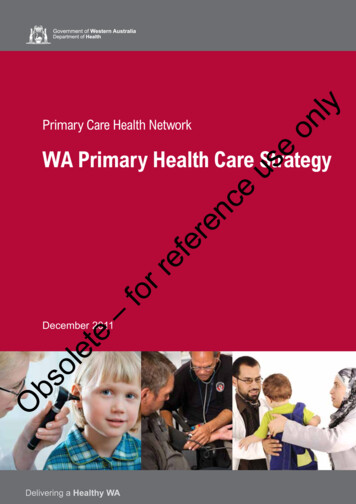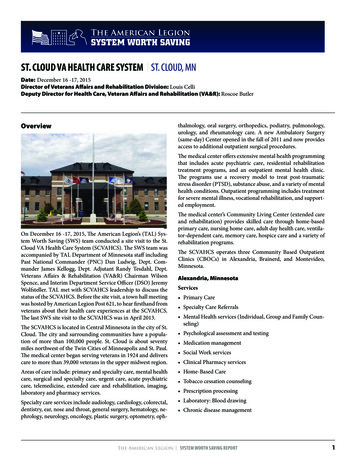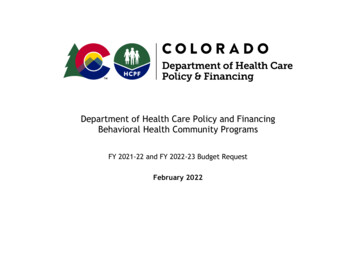
Transcription
Department of Health Care Policy and FinancingBehavioral Health Community ProgramsFY 2021-22 and FY 2022-23 Budget RequestFebruary 2022
FY 2022-23 BUDGET REQUEST: BEHAVIORAL HEALTH COMMUNITY PROGRAMS NARRATIVETABLE OF CONTENTSBEHAVIORAL HEALTH COMMUNITY PROGRAMS . 2History and Background Information . 2Program Administration. 4Medicaid Anti-Psychotic Pharmaceuticals . 4Behavioral Health Capitation Payments and Medicaid Behavioral Health Fee-for-Service Payments . 5Exhibit AA - Calculation of Current Total Long Bill Group Impact . 8Exhibit BB - Calculation of Fund Splits. 8Exhibit CC - Behavioral Health Community Programs Summary . 11Exhibit DD - Behavioral Health Caseload, Per Capita, and Expenditure History . 12Exhibit EE - Estimate and Request by Eligibility Category . 13Incurred-but-not-Reported Estimates . 14Exhibit FF - Behavioral Health RAE Enrollment Adjustment . 15Exhibit GG - Behavioral Health Capitation Rate Trends and Forecasts . 15Exhibit HH - Forecast Model Comparisons . 16Capitation Trend Models . 16Exhibit II - Reconciliations. 19Exhibit JJ – Alternative financing populations . 20Exhibit KK - Medicaid Behavioral Health Fee-for-Service Payments . 23Exhibit LL - Global Reasonableness Test for Behavioral Health Capitation Payments . 23Page S-2.1COLORADO DEPARTMENT OF HEALTH CARE POLICY AND FINANCING
FY 2022-23 BUDGET REQUEST: BEHAVIORAL HEALTH COMMUNITY PROGRAMS NARRATIVEBEHAVIORAL HEALTH COMMUNITY PROGRAMSThe following is a description of the budget projection for the Behavioral Health Community Programs.History and Background InformationIn 1993, under Section 1915 (b) and Section 1902 (a) of Title XIX of the Social Security Act, the Centers for Medicare andMedicaid Services (CMS) granted the State waivers that allowed the State to implement a pilot managed care behavioralhealth program. The pilot program operated until 1995. In 1995, SB 95-078 directed the Department and the Departmentof Human Services to implement a statewide capitated mental health managed care program. In 1997, SB 97-005authorized the Department to provide behavioral health services through a managed care program.The structure of managed care has changed over time. In 1995, implementation of the Behavioral Health CapitationProgram in 51 counties of the State was complete, with the remaining 12 counties added in 1998. A 64th county wasadded when Broomfield became a county in November 2001. Through a competitive bid process, eight behavioral healthassessment and service agencies were awarded contracts to be service providers in the program. Again, throughcompetitive procurement, the Department reduced the number of regions from eight to five and awarded managed carecontracts to five behavioral health organizations effective January 1, 2005. The five behavioral health organizations wereagain procured through a competitive bid process effective July 1, 2009. As a result of the reprocurement, the same fiveorganizations won their respective contract bids, leaving the program unchanged. In July 2014, the Department wentthrough another competitive bid process to reprocure the contractors of the five behavioral health regions. As a resultof this reprocurement, four of the five prior behavioral health organizations won their respective rebids. The only changewas in the northeast region. Access Behavioral Care Northeast began providing services in this region effective July 1,2014. The Department implemented the Accountable Care Collaborative Phase II, starting July 1, 2018, through HB 171353 “Implement Medicaid Delivery and Payment Initiatives”. The program integrated behavioral health services andphysical health services under one administrative entity called a regional accountable entity. The Department underwenta competitive bidding process to procure contractors for the seven regional accountable entities to be service providersfor physical and behavioral health. These changes are effective July 1, 2018.Each regional accountable entity is responsible for providing or arranging medically necessary behavioral health servicesto Medicaid-eligible adults 65 and older, individuals with disabilities through 64, MAGI parents and caretakers, MAGIadults, eligible children, foster care children, and breast and cervical cancer program adults enrolled with a behavioralhealth organization. Services provided by those organizations include, but are not limited to: inpatient hospitalization,Page S-2.2COLORADO DEPARTMENT OF HEALTH CARE POLICY AND FINANCING
FY 2022-23 BUDGET REQUEST: BEHAVIORAL HEALTH COMMUNITY PROGRAMS NARRATIVEpsychiatric care, rehabilitation, and outpatient care; clinic services, case management, medication management,physician care, substance use disorder; and non-hospital residential care as it pertains to behavioral health. Thecapitation program also includes alternatives to institutionalization. The Department is required to make monthlycapitation payments to contracted regional accountable entities for services for each eligible Medicaid recipient.Payments vary across each regional accountable entity, as well as each eligibility category.Since the inception of the Behavioral Health Community Programs, the Department has been responsible for oversightand contracting with the managed care organizations. The budget projections, day-to-day operations, and administrationof the program were the responsibility of the Department of Human Services. In 2004, the administration andprogrammatic duties were transferred from the Department of Human Services to the Department. These duties includebudget projections and accounting for the program, site reviews of the institutions, and contract negotiations. Thetransfer resulted in a new Long Bill group for the Department in the FY 2004-05 Long Bill (HB 04-1422). Subsequently, SB05-112 transferred: (1) the Mental Health Administration appropriation for Personal Services, Operating Expenses, andExternal Quality Review Organization Mental Health from Behavioral Health Community Programs – ProgramAdministration to the Executive Director’s Office Long Bill group; (2) Single Entry Point case management services fromMedicaid Mental Health Fee-for-Service Payments to Medical Services Premiums; and (3) services for the developmentallydisabled from the Colorado Department of Human Services for People with Disabilities – Community Services and RegionalCenters to Non-Emergency Medical Transportation, Medical Services Premiums, and Mental Health Fee-for-Serviceappropriations within the Department. As a result, only the Behavioral Health Community Programs expenditures areaddressed in this section.The recent history of the Behavioral Health Community Programs is summarized as follows: HB 17-1353, “Implement Medicaid Delivery & Payment Initiatives”, authorized the Department to implementperformance-based payments for medical providers. The payments are designed to incentivize BHOs to achieveperformance-based goals regarding improving health outcomes, coordinating care, and containing costs. The bill alsoimplemented the integration of behavioral health and physical health services under the new Regional AccountabilityEntity (RAE). Effective July 1, 2018, the Department began working with the new RAEs instead of the BHOs. Althoughcare will be integrated between behavioral health and physical health services under one entity, the Department stillpays actuarially sound capitation rates for behavioral health services. Therefore, there will be no changes to theforecasting methodology.Page S-2.3COLORADO DEPARTMENT OF HEALTH CARE POLICY AND FINANCING
FY 2022-23 BUDGET REQUEST: BEHAVIORAL HEALTH COMMUNITY PROGRAMS NARRATIVE HB 18-1136, “Substance Use Disorder Treatment”, authorized the Department to add residential and inpatientsubstance use disorder services, and medical detoxification service to the behavioral health program. The Departmentanticipates that residential and inpatient substance use disorder service and medical detoxification services will beginJanuary 1, 2021 after the Department seeks and receives federal authorization to secure federal financialparticipation in the program. The Department currently is forecasting the cost of the program based on a reportproduced by Colorado Health Institute called “Options for Residential and Inpatient Treatment of Substance UseDisorder1”, which was authorized under HB 17-1351 “Study Inpatient Substance Use Disorder Treatment” but assumingthat the program will not reach full capacity until FY 2021-22. The Department will incorporate the costs of the newbenefits through the Department’s rate setting process for the RAEs and will make corresponding adjustments toestimated expenditure through the regular budget process.Program AdministrationIn FY 2005-06, SB 05-112 transferred all Behavioral Health Community Programs - Program Administration expendituresinto the Executive Director’s Office Long Bill group and they are reflected in the lines for Personal Services, OperatingExpenses, and Behavioral Health External Quality Review Organization. The current year and out-year requests forProgram Administration are included in the Executive Director’s Office Long Bill group.Medicaid Anti-Psychotic PharmaceuticalsPrior to FY 2008-09, as part of the Long Bill, estimated expenditures for anti-psychotic pharmaceuticals wereappropriated to this Long Bill group as Cash Funds Exempt. This was an informational-only line item; the costs for thesedrugs were and are paid in the Department’s Medical Services Premiums Long Bill group, and no actual transfer tookplace. Because there was no corresponding decrease to the Medical Services Premiums Long Bill group, this doublecounted the funding for these drugs.In its November 1, 2007 Budget Request, the Department officially requested the removal of the Medicaid Anti-PsychoticPharmaceuticals line item and subsequently received approval. The Department continues to report expenditure stance-use-disorderPage S-2.4COLORADO DEPARTMENT OF HEALTH CARE POLICY AND FINANCING
FY 2022-23 BUDGET REQUEST: BEHAVIORAL HEALTH COMMUNITY PROGRAMS NARRATIVEantipsychotics in its Budget Request (such as in Exhibit F of the exhibits for Medical Services Premiums, and/or theStrategic Plan).Significant Changes between FY 2020-21 S-2 and Spending AuthorityFY 2021-22In the FY 2021-22 S-2, the Department requests a reduction of 22,574,832 in total expenditure compared to the R-2,including a reduction of 22,419,185 General Fund, a reduction of 3,421,236 cash funds, and an increase of 3,265,589federal funds. This is primarily because the Department expects to receive 33,301,437 in risk corridor recoupmentsfrom the RAEs for services incurred in FY 2020-21 under the new substance use disorder benefit. The benefit wasimplemented in January 2021 but utilization ramped up more slowly than anticipated.This is slightly offset by an increase in expected caseload. The change in fund splits is primarily due to the extension ofPublic Health Emergency and therefore the extension of the 6.2% enhanced FMAP bump.FY 2022-23In the FY 2021-22 S-2, the Department forecasts an increase of 72,698,230 in total expenditure compared to the R-2including 12,738,227 General Fund, 5,637,073 cash funds, and 54,332,930 federal funds. This is due to an expectedincrease in caseload and an expected increase in the rates. The Department projects rates to increase by more thanpreviously forecasted in FY 2022-23 due to the RAEs expanding their provider networks and serving both a higher volumeof members and rendering more services to existing utilizers. This includes both serving members with low-acuity mentalhealth challenges as well as high-acuity issues like substance-use disorders.Behavioral Health Capitation Payments and Medicaid Behavioral Health Fee-for-Service PaymentsThe Behavioral Health Capitation Payments line item reflects the appropriation that funds behavioral health servicesthroughout Colorado through managed care providers contracted by the Department. As a result of competitiveprocurement, five behavioral health organizations were awarded contracts with updated capitation rates and serviceseffective January 1, 2005. Payments for Mental Health Institute Rate Refinance Adjustment, Alternatives to InpatientHospitalization at the Mental Health Institute at Pueblo, Alternatives to Inpatient Hospitalization at the Mental HealthInstitute at Fort Logan, and Alternatives to the Fort Logan Aftercare Program were separate payments prior to FY 2005Page S-2.5COLORADO DEPARTMENT OF HEALTH CARE POLICY AND FINANCING
FY 2022-23 BUDGET REQUEST: BEHAVIORAL HEALTH COMMUNITY PROGRAMS NARRATIVE06 and incorporated into the Behavioral Health Capitation Payments line item in FY 2005-06. Effective July 1, 2009, thefive behavioral health organizations were reprocured through a competitive bid process. As a result of thereprocurement, the same five organizations won their respective contract bids, leaving the program unchanged. EffectiveJuly 1, 2014, the behavioral health services contracts were up for reprocurement through a competitive bid process.Four of the five BHOs from the previous rebid won their respective regions with the exception of the northeast region.That region is now managed by Access Behavioral Health – Northeast. The Department underwent a competitive biddingprocess to procure contractors for the seven regional accountable entities to be service providers for physical andbehavioral health. These changes were effective July 1, 2018.The regional accountable entities are responsible for providing or arranging all medically necessary behavioral healthservices to Medicaid-eligible members within a specified geographic location for a pre-determined capitation rate. TheDepartment pays actuarially certified rates to each regional accountable entity for each Medicaid client in each Medicaideligibility category. Retroactive eligibility is covered. Payments vary across regional accountable entities, as well aseligibility categories.The Medicaid populations that are eligible for behavioral health services covered by capitation rates are combined intoeight categories, as indicated below. Partial dual-eligible members and non-citizens are ineligible for behavioral healthservices.The eligible behavioral health populations are: Adults 65 and OlderIndividuals with DisabilitiesLow Income AdultsExpansion Parents & CaretakersMAGI AdultsEligible ChildrenFoster CareBreast and Cervical Cancer Prevention and Treatment ProgramPage S-2.6COLORADO DEPARTMENT OF HEALTH CARE POLICY AND FINANCING
FY 2022-23 BUDGET REQUEST: BEHAVIORAL HEALTH COMMUNITY PROGRAMS NARRATIVEAnalysis of Historical Expenditure Allocations across Eligibility CategoriesAt the beginning of a contract cycle, behavioral health organization capitation rates were entered in the MedicaidManagement Information System (MMIS). Monthly payments were paid based on eligibility categories. The MMIS provideddetailed expenditures by behavioral health organization and eligibility category but did not include offline transactionsand accounting adjustments. The only source that included all actual expenditure activity was the Colorado FinancialReporting System (COFRS). The drawback was the COFRS provided total expenditures, but not by eligibility category.The exception was the Breast and Cervical Cancer Treatment Program eligibility category, which was reported separatelyin the COFRS. Since an allocation had to be calculated to determine the amount of actual expenditures across the othereligibility categories, a ratio was calculated for each eligibility category by dividing the MMIS eligibility categoryexpenditures (less the Breast and Cervical Cancer Treatment Program eligibility category) by the total MMIS expenditures(less the Breast and Cervical Cancer Treatment Program eligibility category). The ratio for each category was multipliedby the total expenditures (less the Breast and Cervical Cancer Treatment Program eligibility category) from the COFRS.This calculation estimated actual COFRS expenditures across each eligibility category. Beginning July 1, 2014, theDepartment is using a new financial reporting tool. The Colorado Operations Resource Engine (CORE) is used in place ofCOFRS and the same overlay methodology is used between CORE and the MMIS.Description of MethodologyThe Department utilizes a capitation trend forecast model. In short, the methodology examines the trend in capitationrates across each eligibility category and applies that trend to the average per-claim, incurred expense rate. Byexamining the capitation rate trends directly, rather than through a per-capita methodology, future expenditures areforecasted directly through the primary cost drivers: the actuarially agreed-upon capitation rate and caseload. By tyingforecasts directly to capitation rates, the methodology may provide more accurate estimates of expenditures byeligibility category, rather than simply in aggregate, as well as provide an additional window of transparency into theforecasting process by presenting a clear link between total expenditure and the rates being paid to regional accountableentities.Additionally, the forecast utilizes an incurred but not reported methodology similar to other portions of this Requestsubmitted by the Department (e.g., Nursing Facilities; see Section E, Exhibit H). The Department adjusts its request tocapture the reality that some behavioral health claims incurred in any one fiscal year may not be paid during that samefiscal year. Similarly, some portion of expenditure in any fiscal year will be payments on claims incurred in prior fiscalyears.Page S-2.7COLORADO DEPARTMENT OF HEALTH CARE POLICY AND FINANCING
FY 2022-23 BUDGET REQUEST: BEHAVIORAL HEALTH COMMUNITY PROGRAMS NARRATIVEThe following narrative describes in greater detail the assumptions and calculations used in developing the current yearand out-year requests for Behavioral Health Community Programs. It should be noted that the data and values in manyof the exhibits are contained and calculated in one or more other exhibits which may come before or after the exhibitbeing described. When this occurs, the source exhibit will be noted.EXHIBIT AA - CALCULATION OF CURRENT TOTAL LONG BILL GROUP IMPACTEffective with the November 2, 2009 Budget Request, in this exhibit the Department sums the total spending authorityby fund source, including the Long Bill and any special bills which have appropriations that affect the Department. Thetotal spending authority is compared to the total projected estimated current year expenditures from Exhibit BB. Thedifference between the two figures is the Department’s Supplemental Request for the current fiscal year.Exhibit AA now presents a concise summary of spending authority affecting the Behavioral Health Community Programs.In previous budget requests, the Department presented historical expenditure and caseload figures in graphical form.This information can be found in table form in Exhibit DD (see below).For the request year, the Department starts with the prior year’s appropriation including special bills and adds in anyrequired annualizations. This total is the Base Amount for the Request year. The total Base Amount is compared to thetotal projected estimated request year expenditure from Exhibit BB. The difference between the two figures is theDepartment’s Funding Request in the November Budget Request and the Department’s Budget Amendment in theFebruary Supplemental Budget Request.EXHIBIT BB - CALCULATION OF FUND SPLITSExhibit BB details fund splits for all Behavioral Health Community Programs budget lines for the current fiscal yearsupplemental and the out-year Budget Request. For all of the capitation payments for the base traditional members, thestate receives the standard Medicaid federal match with the State’s share coming from General Fund. In FY 2018-19 andongoing the federal match is 50.00%. Payments for members in the Breast and Cervical Cancer Program receive anenhanced federal match rate, which in FY 2021-22 and ongoing is 65.00% and is described separately below.Following the declaration of a public health emergency by the Secretary of Health and Human Services during the COVID19 pandemic, CMS notified states that an increased FMAP would be available for each calendar quarter occurring duringthe public health emergency, including retroactively to January 1, 2020. To be eligible to receive the 6.2 percentagePage S-2.8COLORADO DEPARTMENT OF HEALTH CARE POLICY AND FINANCING
FY 2022-23 BUDGET REQUEST: BEHAVIORAL HEALTH COMMUNITY PROGRAMS NARRATIVEpoint FMAP increase, states must adhere to a set of requirements which include, but are not limited to, maintainingeligibility standards, methodologies, and procedures; covering medical costs related to the testing, services, andtreatment of COVID-19; and not terminating individuals from Medicaid if such individuals were enrolled in the Medicaidprogram as of the date of the beginning of the emergency period or during the emergency period. The Department iscompliant with all requirements and assumes that the State will be eligible for the enhanced FMAP through the end ofFY 2021-22. The Department anticipates that this FMAP bump will end on June 30th, 2022 following the projected endof the public health emergency. Additionally, the American Rescue Plan Act (ARPA) authorized a 10% FMAP bump allowingfor up to a 95% FMAP on all rehabilitation services for the first 3 quarters of FY 2021-22. An estimated 84% of thebehavioral health expenditure qualifies for the FMAP bump, resulting in the blended FMAPs listed below. FMAP forecastscan be found in exhibit R of the Department’s FY 2022-23 R-1 “Medical Services Premiums Request”. The chart belowshows the average FMAP for the year.Capitation expenditures are split between traditional members and expansion members. Expansion members are fundedfrom Healthcare Affordability and Sustainability Fee funds. Finally, the reconciliation from prior years for behavioralhealth capitation overpayments, retractions for capitations paid for members later determined to be deceased, andsystem issues are also presented (see Exhibit II for reconciliation calculations). A summary of applicable FMAP rates foreach of the forecast years is provided below:PopulationFY 2021-22 Match RateFY 2022-23 Match RateFY 2023-24 Match RateStandard Medicaid62.53%50.00%50.00%Former CHP Children69.34%65.00%65.00%Former CHP Prenatal69.34%65.00%65.00%Expansion Adults92.49%90.00%90.00%BCCP69.34%65.00%65.00%Page S-2.9COLORADO DEPARTMENT OF HEALTH CARE POLICY AND FINANCING
FY 2022-23 BUDGET REQUEST: BEHAVIORAL HEALTH COMMUNITY PROGRAMS NARRATIVEThe Department also calculates the fund splits for the fee-for-service expenditure in Exhibit BB. The make-up of the feefor-service population is the same as the capitation program and therefore the same funding mechanisms are used forthe same populations mentioned above in the fee-for-service environment (see Exhibit JJ and Exhibit KK for fee-forservice calculations).Medicaid Behavioral Health Fee-for-Service base traditional members also receive the standard Medicaid federal matchwith the State’s share coming from General Fund. Similar to the populations within the capitation payments line, as ofJuly 1, 2014, the Department is breaking out the fee-for-service expenditure by funding source according to populationso that it may claim the correct federal match associated with who is obtaining services. The sum of the capitations andthe fee-for-service payments comprise the Department’s request.Behavioral Health Services for Breast and Cervical Cancer Program AdultsSB 01S2-012 created the Breast and Cervical Cancer Prevention and Treatment Program. SB 05-209 and HB 08-1373incorporated funding for the Breast and Cervical Cancer patients into the appropriation for Behavioral Health CommunityPrograms Capitation Payments, effective with the FY 2005-06 budget. Behavioral health care for members in the Breastand Cervical Cancer Program is managed through the capitation contracts with the regional accountable entities.Therefore, the budget is based on the behavioral health caseload that includes the Breast and Cervical Cancer Programeligibility category. For this reason, they are shown as a separate eligibility category where appropriate.Annual designations of General Fund contributions to program costs are specified in sections 25.5-5-308(9), C.R.S. (2015).Exhibit BB details funds splits for the Behavioral Health Community Programs Capitations line. Excluding the FMAP bumpduring the emergency period, the funding for the members enrolled in the program is 35.00% cash funds from the Breastand Cervical Cancer Prevention and Treatment Fund and 65.00% federal funds. The program was reauthorized in FY 201415 and sunsets at the end of FY 2018-19, with the potential to extend the program through new legislation. Beginning inFY 2016-17, the Breast and Cervical Cancer Prevention and Treatment Program expanded the age of eligibility for womenbeing screened for cervical cancer from 39 to 21, which impacts the caseload forecast.Behavioral Health Services for Healthcare Affordability and Sustainability Fee Expansion MembersHB 09-1293 established a funding mechanism for a series of expansion members. The first set of expansion members thatare funded through the bill was parents with income up to 100% of the Federal Poverty Limit (FPL). Services for thesemembers were funded through the Healthcare Affordability and Sustainability Fee cash fund. Starting in FY 2011-12,Page S-2.10COLORADO DEPARTMENT OF HEALTH CARE POLICY AND FINANCING
FY 2022-23 BUDGET REQUEST: BEHAVIORAL HEALTH COMMUNITY PROGRAMS NARRATIVEadditional expansion populations also received funding through the Healthcare Affordability and Sustainability Fee cashfund. These include individuals with disabilities with income limits up to 450% of the federal poverty level and MAGIAdults, both of which received services through the RAEs as part of their benefit package. Individuals with disabilitieswith income limits up to 450% are assumed to be similar to other members with disabilities, and expenditure for thesemembers is therefore calculated using the same per-capita rate as other members with disabilities (see exhibit JJ). Seeexhibits EE, GG, II, and JJ for more detailed explanations of these assumptions.Behavioral Health Services for Expansion Populations in SB 11-008 and SB 11-250In addition to the FMAP bump during the emergency period, the former CHP populations that transferred to Medicaidwith SB 11-008 (Eligible Children) and SB 11-250 (Eligible Pregnant Adults) receives the enhanced CHP FMAP ofapproximately 65.00%; the enhanced FMAP is expected to be 67.17% in FY 2021-22 and 65% afterwards per the HEALTHYKIDS Act.Behavioral Health Services for Expansion populations in SB 13-200SB 13-200, “Expanding Medicaid Eligibility in Colorado,” extends Medicaid eligibility to up to 133% of the FPL parents ofMedicaid eligible children and MAGI Adults, effective January 1, 2014. The Department assumes that federal match rateswill apply to each new population as follows: Parents from 60% to 68% FPL will receive the standard Medicaid match rate,with the state share coming from Healthcare Affordability and Sustainability Fee cash fund. Parents from 69% - 133% FPLand newly eligible MAGI Adults will receive the expansion federal match rate. And adults up to 60% FPL will continue toreceive the standard Medicaid match. The Department also estimates that the non-newly eligible MAGI Adult populationis 81.13%; Because some of these members may have been eligible prior to the expansion, the Department is unable toclaim the expansion federal match. Therefore, the Department estimates that it can claim the expansion match on 75%percent of the population and the standard match on the other 25%. As such, the federal match percentage in FY 201910 is 81.13%. Beginning January 1, 2017, all expansion populations will begin a stepdown in federal matching. As a result,the match rate for those populations in 91.50% in FY 2019-20, and 90.00% in FY 2020-21 and ongoing.EXHIBIT CC - BEHAVIORAL HEALTH COMMUNITY PROGRAMS SUMMARYExhibit CC presents a summary of behavioral health caseload and capitation expenditures itemized by eligibility categoryas well as a summary of the rest of the Behavioral Health Community Programs. The net capitation payments include th
through another competitive bid process to reprocure the contractors of the five behavioral health regions. As a result of this reprocurement, four of the five prior behavioral health organizations won their respective rebids. . physician care, substance use disorder; and non-hospital residential care as it pertains to behavioral health. The .
